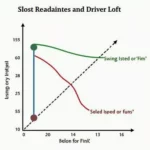Golf is a game that blends skill, concentration, and strategy. For many players, understanding what the average golfer shoots can be enlightening and form a benchmark for improvement. Whether you’re new to the green or a seasoned player, knowing the typical scores can help you set achievable goals and better your game.
Understanding Golf Scores
In golf, each course presents a par value, which is the number of strokes an expert golfer would take to complete the course. Scoring below par typically indicates a good performance, while scoring above par signals room for improvement.
What is Par?
- Par: The number of strokes that an expert golfer is expected to need to complete the course.
- Birdie: One stroke under par.
- Eagle: Two strokes under par.
- Bogey: One stroke over par.
- Double Bogey: Two strokes over par.
Average Golf Score
According to recent studies, the average golf score for amateur golfers hovers around 90 to 100 strokes for 18 holes. Here’s a breakdown of various skill levels:
| Skill Level | Average Score |
|---|---|
| Beginner | 100-120 |
| Intermediate | 85-95 |
| Advanced | 75-85 |
| Scratch Golfer | Below 70 |
Factors Affecting Scores
Understanding what affects an average golfer’s score is crucial. Here are some key factors:
- Experience Level: Newer players tend to score higher due to a lack of skill.
- Course Difficulty: More challenging courses will yield higher scores.
- Weather Conditions: Windy or rainy days can impact performance.
- Health & Fitness: Physical condition plays a role in stamina and swing efficiency.
- Equipment Quality: Using suitable clubs can influence scoring.
 Amateur Golfers on the Course
Amateur Golfers on the Course
The Impact of Handicap
A golfer’s handicap is a measurement of their potential ability, expressed as a number that allows players of varying skill levels to compete against each other.
- Higher handicaps indicate less skill, while lower handicaps signify more skilled players.
- The Universal Golf Handicap System provides a fair way to level the playing field, allowing an average golfer to compete with lower-handicapped players.
What is a Typical Handicap?
Here’s a look at typical handicaps and their corresponding approximate scores:
| Handicap Range | Typical Average Score |
|---|---|
| 0-5 | 70-75 |
| 6-12 | 75-85 |
| 13-20 | 85-95 |
| 21+ | 100+ |
Goals for the Average Golfer
If you’re looking to improve your game, understanding how to set realistic goals can help. Here are some strategies:
- Practice Regularly: Consistency is key.
- Analyze Your Game: Use statistics to identify strengths and weaknesses.
- Set Incremental Targets: Aim for a specific score drop—like from 100 to 90—rather than just wanting to “get better.”
- Invest in Lessons: Professional guidance can help refine your skills.
 Analyzing the Scorecard
Analyzing the Scorecard
Tips for Lowering Your Score
To become one of those average golfers who shoot lower scores, consider these tips:
- Improve your short game: Many strokes can be saved on the green with better putting and chipping skills.
- Play More Often: The more you practice, the more comfortable you’ll become.
- Course Management: Learn when to play safe and when to take risks.
- Mental Preparation: Focus on your mental game, as it greatly influences performance.
Equipment Matters
Having the right gear can influence your ability to score well. Here’s what to consider:
- Clubs: Invest in a decent set that suits your height and swing dynamics.
- Balls: Higher-quality balls can offer better flight and control.
- Shoes: Comfortable, supportive footwear can make a world of difference in your game.
 Golfer Preparing to Tee Off
Golfer Preparing to Tee Off
Key Takeaways
- The average golf score for amateur players is typically 90 to 100 strokes.
- Various factors such as experience, course difficulty, weather, and health can affect scores.
- A golfer’s handicap measures potential ability and helps level the playing field.
- Setting realistic goals and practicing regularly are essential for improvement.
- Investing in quality equipment can enhance your performance.
FAQ
Q1: What score is considered average for amateur golfers?
A1: The average score for amateur golfers ranges from 90 to 100 strokes for 18 holes.
Q2: How does a handicap affect my golf game?
A2: A handicap allows players of different skill levels to compete fairly by adjusting their scores.
Q3: What are some common strategies to lower my golf score?
A3: Key strategies include improving your short game, practicing regularly, and learning course management.
Q4: How important is the equipment in improving my golf score?
A4: Having the right equipment, like quality clubs and balls, can significantly impact your performance and scores.
Q5: How often should I play to improve my game?
A5: Regular practice is essential—aim for at least once a week if possible.
Q6: Can weather conditions affect my golf score?
A6: Yes, unfavorable weather like windy or rainy conditions can impact performance.
Q7: What should my focus be as a beginner golfer?
A7: Beginners should focus on basic swing mechanics, putting, and developing a feel for the game.
Q8: Should I take golf lessons?
A8: Yes, professional lessons can help identify areas for improvement and provide tailored feedback.
Q9: How can I track my progress over time?
A9: Keep a record of your scores and analyze trends to see where you can improve.
Q10: Is it common for golfers to hit 100 or more strokes?
A10: Yes, it is entirely common for amateur golfers, especially beginners, to score over 100.
Understanding the average golfer’s score is a fundamental aspect of improving your own game. By keeping these statistics, goals, and strategies in mind, you’ll be well on your way to lowering your score and enhancing your skills on the green!

